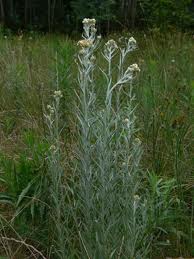| PlantID | 0081 |
| Botanical Name | Gnaphalium luteo-album |
| Common Name | Bal Raksha |
| Classification | | Kingdom: | Plantae | | Subkingdom: | Tracheobionta | | Division: | Magnoliophyta | | Class: | Magnoliopsida | | Subclass: | Asteridae | | Order: | Asterales | | Family: | Asteraceae | | Genus: | Gnaphalium | | Species: | luteo-album |
|
| Part used | Leaves. |
| Medicinal Properties | Leaves: astringent and vulnerary. |
| Medicinal Use | Leaves: useful in wounds and burns, also used internally to check discharge of blood serum or mucous secretions. |
| Chemistry | Flowers: chalcone glucoside(I) which is characterised as 2',4,4'-trihydroxy-6-methoxychalcone-4'-glucoside, luteolin and its 4'-D-glucoside. |
| Cultivation | NA |
| Regional Habitat | Commonly occurs along the bank of rivers, hillsides, wetlands, drainage areas, near temporary water bodies. Sand, loam, clay and peaty soils over limestone, granite. Dist: Ganganagar, jodhpur, pali, sirohi, bundi, bhilwara, bharatpur, swai-madhopur.
|
| Description | Erect ascending, wooly annual herbs, grows up to 70 cm high, often woody at base. Stem: simple, usually corymbosely branched above. Leaves: sessile, semi-amplexicaul at base, oblong, spathulate or oblanceolate, wooly on both surfaces, apex obtuse, sometimes mucronate, margins entire, those at apical nodes linear-oblong, acute. Flowers: capitula borne in dense terminal corymbs, golden-yellow, glistening; involucre bracts shining, straw-coloured, sub-herbaceous at base and transparent towards apex, outer ones ovate, sub-acute, inner linear, acute or sub-acute. Ray-florets: numerous, pappus shorter than the involucre. Disc-florets: slender; style-branches truncate; cypsels oblong, papillose. Flowers and fruits appears during October-April. |
| Image |  |


